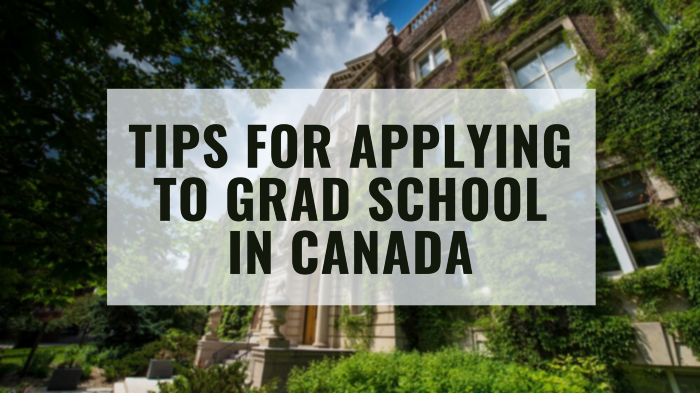Last year, Laura wrote a post on how to write a successful grad school application. Her tips are awesome and I followed a lot of what she suggested in my own process of writing my applications for Master’s programs. So, I figured, why not give you folks some more tips and tricks about not only the application process but on navigating the acceptance process?


Tip #1: Start early
I cannot stress this one enough. The application process is grueling, not just because of the added workload in curating a statement of interest or research proposal, but also in searching for the programs that best fit what you want to do, searching for supervisors that you would want to work with, and applying for any external funding opportunities like the Canadian Graduate Scholarship — Master’s offered by the Tri-Council (more on this below!)
I started writing applications in early September for deadlines in November, early October for deadlines in December, and November for deadlines in January. This gave me about two months to work on each respective application. The nice thing is, if your programs are similar and you plan on doing the same research at each one, some of the main chunks of writing (like a research proposal) can be tweaked to fit a couple different programs, saving you a lot of time. But I must stress: you need to make sure your application stands out and takes into consideration why you fit at that particular school. Why does their program stick out? Are there members of their faculty whose research fits your? How will your skills contribute to their program? Admission committees can see through a template statement of interest very easily and that won’t be good for your chances of getting in, so make sure you’re highlighting exactly why you’d be great in their program. Oh and ALWAYS ctrl+F to make sure you’ve used the right school’s name. Don’t be that guy who sends U of A your U of C letter.
Tip #2: Apply for the Canadian Graduate Scholarship — Master’s
I didn’t know this was a thing until about a month before the deadline for this application, and a lot of undergrads don’t know they can apply for this scholarship before their first year of their Master’s. The Canadian Graduate Scholarship — Master’s (CGS-M) is funded by the Tri-Council. Since the programs I was applying to fit under the umbrella of social science, I applied for the Social Sciences and Humanities Research Council — CGS-M funding. I recommend you start looking into the requirements for the CGS-M in September, giving you a ton of time to actually curate that application. Just like every other application, you’ll need references, a research proposal and a bunch of other specifics like a Canadian Common CV and to figure out their application system all together. This process isn’t difficult, but it takes time. So do yourself a favour and start early!
Tip #3: Ask an academic to give you feedback
For a lot of us, this is the first time we’re writing this particular kind of letter or proposal. Depending on the program, the statement of interest or the research proposal can look very different than what you’re used to doing. By the time I wrote my Master’s application statements I had written two statements of purpose for law school, which require a slightly different kind of writing.
Writing these can be tough, no doubt, and sometimes schools don’t give you a full list of things they expect you to address. As a result, I asked professors who were writing my references if they were willing to also give me some general feedback on my application statements. This helped enormously and really ensured my statements were making the most of what is often a short letter (1–2 pages), avoiding any jargon and clearing up any existing gaps in your statement.
Okay, so now you’re in. What’s next?
So now that your actual application woes are over comes the next stage (well, the stage after about a month of anxiety): choosing which program you want out of what might be a plethora of really great offers. For me, I had applied to three Master’s programs so the decisions I had to make were thankfully amongst a small number of relatively comparable offers. I heard back from two of the applications within a month and a half of applying, but it took four months for me to hear back from the last one. Long story short: don’t be freaked out if it’s taking a bit longer, but make sure you’re keeping in track of your offers because some have strict deadlines. The offers I received gave me two weeks to respond and confirm.
Tip #4: Money matters
This brings me to what played a huge role in making my decision: Money. For me, two schools tacked on funding to their offers which was really awesome! What I’ve been told by professors and advisors is if a school is willing to throw some $$ behind you to get you started and another isn’t for the same program, it really speaks to how much the school wants you there. Scholarships, graduate funding, and external scholarships will all play a major role in your quality of life when you start the program, so you should really weigh heavily how much a program is willing to give you in your decision making process.
Tip #5: The feels
This one is interesting. It’s weird because you don’t really expect an institution to give you ~general feelings of warmth and fuzziness~ but then advisors, offer letters, and the support offered by the program can make you feel a lot like wow! You really want me to be a part of your program! This can come from consistent email responses, orientation sessions, money, or even just the prospect of attending that school. You want to feel like the school you’re choosing really appreciates and values the talents you’re bringing to the table, because at the end of the day, it’s about a good match for both parties: you and the school.
Source: University of Alberta








































